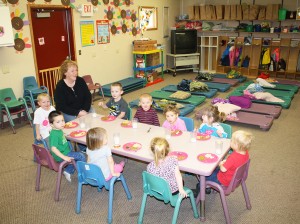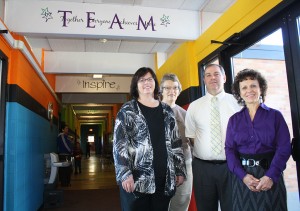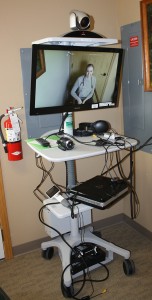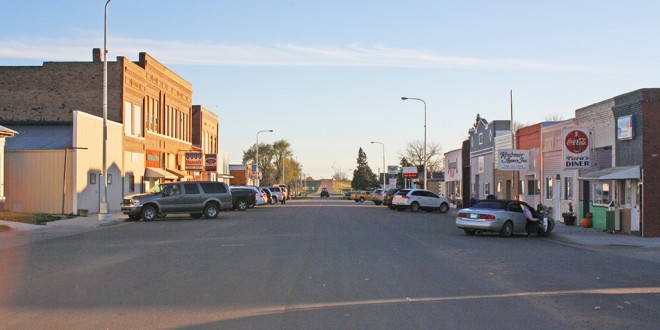White Lake, S.D., may see itself as a “bedroom community” to nearby Mitchell and Chamberlain, but the town of 450 has found its own ways to stand strong.
“The bigger population centers … have a tendency to grow, and if we’re close enough to those population centers, we can” benefit from that growth, said Ron Gillen, known around town as one of White Lake’s biggest cheerleaders. “We may be small, we may be simple, but it’s an awful nice place to raise kids, and you don’t have a lot of worries.”

White Lake residents rallied when the community’s only daycare center closed in 2012. White Lake Community Daycare Director Jacki Konechne and others in town say keeping childcare available locally is key to the success of small towns competing to be “home” for people who commute to larger regional centers for work.
Daycare gets community support
When the town’s only daycare center announced it would close in 2012, a group of parents asked city officials to keep it open—something they said was imperative to the community’s survival.
“It would be detrimental to our community if we did not have a daycare,” said Jacki Konechne, director of White Lake Community Daycare. She said daycare parents have indicated they prefer to get gas and groceries before picking up their children—something they can still do in White Lake, despite working outside city limits, as long as their kids are cared for in town. “The fewer transitions that you have, it’s a positive thing for everybody.”
Scott Clites, a White Lake banker whose toddler son goes to the daycare, agreed.
“If that (daycare) wouldn’t have passed, we would be hurting, because if I’m already driving to Chamberlain to go to work and I’ve got to take my kids to Chamberlain to daycare, I might as well take all of my kids to Chamberlain” for school, he said.
The need was evident, according to Konechne.
“There’s not enough grandparents in our community to watch all of the kids,” she said. “We had an influx of children—we had 12 kids born in one year, who came into this building.”
The city-run daycare is on school property. The school contributes the use of a Governor’s House-style building and pays the electrical, water and snow removal bills, while the city funds building improvements and equipment purchases with the help of others in the community.
“Whenever we need something, we ask our parents, and things show up. We tell our … city council people, and things show up,” Konechne said. “We have so much support. … When we had those 12 little ones who came all in the same year, some of our grandmas in the community came in and (rocked them). It was awesome.”

Members of the White Lake teaching staff gather in the breezeway that connects the elementary classrooms to the two-story schoolhouse. Superintendent Bob Schroeder (pictured with, left to right, Sandy Nightingale, Marcia Schuldt and Paulena Hanten) said that corridor is one of many catalysts for a new building project, because its design and access to the school’s backyard community daycare have created a vulnerability for students and staff.
School construction is investment in town’s future
Many school districts would hesitate to invest in a new facility when enrollment is down.
“One-(hundred)-twenty-five is a scary number,” Superintendent Bob Schroeder said, “but we can see that’s potentially going to pick up. … We have a lot of younger families moving in.”
Proving their faith in the future of White Lake, 76 percent of voters who turned out for a November election approved a $5.5 million bond issue for new construction.
Discussion of a new school began in 2002, when enrollment was 177, but the board at that time rejected the idea without bringing it before the public. Thirteen years later, enrollment is down almost one-third (Schroeder reports open enrollment has represented “more than our share” of those losses), but safety and security issues have become obvious.
Schroeder said the school is vulnerable to potential threats due to unmonitored use of a hallway between the elementary and high schools to reach the daycare behind the school.
Though official building plans are yet to be decided, Schroeder said he hoped to move into the new building by the start of the 2017-18 school year. Construction likely will take place in phases, with the high school built directly south of the two-story 1939 schoolhouse first. Then that building would be demolished, and an elementary school would be built in its place. He anticipates the new building will be a single-story facility.
Enrollment has been as low as 108 during Schroeder’s 23-year tenure, he said. And, in 2010, the six elementary grades were combined into three classrooms. The change happened because of budget constraints, but it has had a positive effect, Schroeder said.
“The third-graders are seeing what the fourth-graders are doing. They’re basically a year ahead, a lot of them. And the ones who are more advanced … the teachers aren’t holding them back. They’re helping other kids, they’re growing self-esteem—there are just a lot of benefits to combined classrooms,” Schroeder said, adding that some schools are moving to that model by choice. “We did it out of necessity, but … our testing results speak for themselves. It’s pretty impressive.”
U.S. News & World Report recognized the high school as a one of the best in the nation in 2009 and 2013, Schroeder said, and insisted the students’ success is directly related to the district’s team of seasoned teachers.
Unlike many South Dakota school districts, White Lake has not struggled with finding teachers year after year. The district hired one teacher two years ago, to replace a 40-year teaching veteran, and Schroeder struggled to recall the last hire before that. A majority of the staff has been in place more than 20 years. Community and parent involvement creates a supportive environment for teachers, which also makes teachers more likely to stay, according to Schroeder.

Dustin and Melissa Hillman employ nearly all family at the service station they opened in 2014.
“My uncle is the mechanic, and my grandpa—who used to be the mechanic until a tractor tire blew up on him here—is my maintenance man,” Hillman said.
Yesterday’s youth moving their families ‘home’
“As a teenager, I didn’t care for the town that much,” said Melissa Hillman, but she changed her mind somewhere along the way. She is now raising her three children in a home handed down for generations. “I wanted my kids to go to school here. I loved my school, my teachers. My kids have some of the same teachers I had and my parents had.”
As a parent, Hillman appreciates the extra sets of eyes that make sure her daughters are behaving.
Familiarity in the workplace has been a draw for “local kids” to come home as adults.
“I like working with people I know on a daily basis,” said Scott Clites, who grew up 25 miles away, in Stickney, and now lives in the home his wife’s grandparents once occupied. “We wanted to live in a small town, and White Lake just had an opportunity.”
Though some may think making a life in one’s hometown is “settling,” Clites said it’s the opposite.
“It’s tough to get a job in a small town, so you’re more fortunate to get a job,” said Clites, who works at Farmers and Merchants State Bank.

Scott Clites said he is fortunate to have found a banking job in his wife’s hometown, because professional jobs tend to be limited in small towns, but rural life always was the dream he held for raising his family.
On the other side of the coin, banks have had a hard time finding long-term employees. The key seems to be finding employees who are suited to life in a small town.
Fresh college graduates from larger towns often don’t work out. “They’ll be here two years” before missing the amenities of larger communities, he said.
But if employees see small towns as good places to call home, “they’re lifers and stay” their entire careers, Clites said.
Though living and working in a rural community presents the challenge of knowing everyone’s business—especially in banking—Clites said he is happy to be raising his family in White Lake.
“What a small town offers is about all I (need),” he said, adding that he has “no desire” to even recreate in larger communities, because “If you go in there with one person, just you and that one person talk. Here, everybody in there knows you and will talk to you.”

Kris Kieffer says the decision to move back to White Lake after a brief stint on the east coast while her husband was in the military was easy.
A generation ago, John and Kris Keiffer were the returners.
When Kris joined John on a military base in North Carolina after she graduated from beauty school in the 1970s, the local beautician told her, “Don’t stay gone very long.” The woman wanted to move nearer to her daughter, and wanted Kris to take over her shop.
“We knew we had a place to come back to. … We had a house (and) I had a job,” Kris said. “People telling me back then to come back, I kind of poo-pooed it,” but at the end of the year, the couple longed for the relatively crime-free nature of South Dakota.
After 40 years as business owners in their hometown, Kris said, “the best thing we ever did was get married and move back to White Lake. … I wouldn’t do anything different.”
Now president of the White Lake Commercial Club, Kris has made it her mission to hand over the reins of the community to the next generation, much like was done for her four decades ago.
“Every month, I say, ‘Us older ones, we’re fine to step back. It’s you younger ones we want and we’re so happy to see,’” she said. Ten to 15 years ago, “there were no young farmers coming back. Within the last 10 years maybe, I just can’t believe (it). And they’re all coming back to maybe a family farm or … a business, and they’re all having kids.”
With the help of some of the newer residents, who have recently experienced life in other places, the Commercial Club has created monthly community events ranging from meals to educational events to movies in the park. It’s an approach Hillman said is well-suited to White Lake’s needs.
“Nothing that’s open all the time is necessarily going to work, because there just is not enough people to accumulate the business” for a movie theater or bowling alley or other recreational facility, she said, but “anything that they can do to bring people out of their houses” and community-building is a good idea. “There has to be something to do.”

White Lake Mayor Jim Thiry stands in front of White Lake’s shared city hall, public library and newspaper office on Main Street.
Housing is a challenge waiting for community action
The biggest challenge in bringing people back to White Lake is housing, unless a family home has opened up for the next generation.
“Even if you start a housing development … a lot of people in a small town like this—(residents) can’t afford them,” said Clites, who is involved in the White Lake Development Corporation. “There aren’t $80,000-a-year jobs for a wife and a husband to go build a $400,000 house. The $40,000-, $50,000-, $60,000-house is about all they can afford, and everybody wants a $120,000-house.”
For most families living in the White Lake area, he said, one spouse has a healthy income, while the other makes around $10 to $12 per hour.
“That won’t cut it in today’s world,” he said.
Clites is optimistic that the community will find a solution to the housing crunch, but it will take some creativity.
“It’s a town that wants to grow,” he said, citing the daycare and school projects as proof. “Even if we fail at something, at least we can’t say we didn’t try.”
Gillen, who also is involved in the Development Corporation, agreed.
“We do have some control, from the fact that if we want it better, all we have to do is do it ourselves (and) figure out how to pay for it ourselves and just get it done and make it work.”
But the community wasn’t always so optimistic and team-centered.

Ron Gillen says White Lake is an established “bedroom community” that boasts several amenities for those who want to live in a small community but work in a larger regional center.
In the early 1900s, according to Gillen, a lock system had been installed to bring water from Lake Mitchell to White Lake. A three-mile canal was dug, and concrete was poured before someone dynamited the project. Five years ago, Gillen and others presented the idea of finishing the project to local legislators, because the lake has been low in recent years.
“When it’s full, the deepest part of the lake is about 11 feet. But there’s a lot of it that when it’s only half-full, (and) about a third of it is dry,” Gillen said. “To be able to do something like that again was going to take a substantial amount of money, and it was hard to argue from an economic development standpoint (that) filling White Lake was going to … pay for the cost.”
As recently as 10 years ago, community projects were nearly as difficult to move forward.
“For the longest time, if somebody mentioned something positive you, had three people standing there, giving you something negative and telling you reasons it wouldn’t work,” Gillen said.
Mayor Jim Thiry agreed.
“When I first retired back here in … 1994, the town was split into about three cliques,” he said. “You had the ones who wanted to get something done, the ones who absolutely didn’t want to do nothing, and then the ones sitting there in the middle and complained about it.”
But, around 2008, when the economy was slipping in big ways in more urban places, the locals began to realize they needed to cling to the good things they already had.
“You don’t hear any of that now,” Gillen said. Instead, projects like the school, daycare, clinic and a major Main Street reconstruction have been supported by nearly everyone in town.

Natalie and Jeff Briggs, along with Jeff’s family, purchased the White Lake and Stickney grocery stores to prevent the community from losing its grocery store, in an effort to enhance their initial store, in Plankinton, and the region.
Local hunger feeds regional economy
Natalie and Jeff Briggs purchased and updated the former White Lake Community Grocery Store and B’s Market in Stickney in an effort to not only strengthen those communities, but also Plankinton, where Jeff Briggs’s family had owned the grocery store for more than two decades, because they believed that if residents in one of the three communities started having to drive out of town for groceries, they all eventually would follow along.
“Three legs are stronger than one … on a table,” Natalie Briggs said. “With our three stores, it just keeps us all healthy and strong. … If the elderly have to drive 20 (or) 30 miles just to get to the grocery store, they’re probably not going to stay in that small town. Having that store in town keeps everybody in town.”
Because the three stores use more inventory together, Ron’s Market now is able to purchase inventory in bulk, allowing them to meet—or even beat—prices in the larger neighboring communities.
“We can buy pallets of things now, and you get a better price when you order in larger quantities,” Natalie Briggs said. “We can split that pallet up and sell it in all three stores, and still not have to worry about anything out-dating.”

Tia Haines says telemedicine systems such as was installed in the new White Lake Medical Clinic Avera are the future of healthcare in communities that cannot support fulltime medical professionals.
Clinic fills 100-year void
Platte Medical Clinic Avera saw potential when they hired White Lake High graduate Tia Haines as a physician assistant in 2013. They also saw the opportunity to create a medical clinic where one had not been before.
In the early 1900s, a doctor practiced in a shared space, but the arrangement was temporary. Since that practice ended, locals have had to drive at least 35 miles for medical care. While many small towns are losing their medical facilities, Haines said creating one in White Lake makes sense.
“It’s perfect that there’s really not a ton of competition and that it’s available when it never was before,” she said.
Haines is in the clinic a day and a half each week, but she’s available for patients via telemedicine every day but Friday. If patients need to be seen when she isn’t working in White Lake, they can make appointments with Haines’s full-time medical assistant, who can connect through television screens with Haines as she works in Platte or Geddes, and the two can conduct the appointment together. A stethoscope connected to the virtual equipment allows Haines to hear the patient’s heart beat from the other clinics, 30 and 50 miles away, and a televised otoscope and “exam cam” help her get a good look at patients’ ears, throats, skin and other areas of concern.
“It’s kind of the future of medicine for those rural areas,” Haines said. “They can’t afford to have me in White Lake four full days … but with telemed there, we can keep it open and still be a service there. For the rural area, it’s really great.”
But there is a learning curve.
“I don’t know if people fully understand the capabilities of the telemedicine,” she said. “Education is a big part of it, and we’re working on that.”
Haines never imagined being able to live and work in her hometown.
“Without ever having an established clinic in White Lake, who would have ever dreamed that a town of (405) people would ever get a clinic? It was not an even an idea”—especially when many small towns are losing established clinics, she said.
The clinic building previously housed the private daycare center that closed in 2012 and was renovated and opened in July as White Lake Medical Clinic Avera. Two adjoining suites eventually will house other businesses. Gillen, who is chairman of the fundraising committee, called the building “a big deal for” the community. Initially, the committee set its goal at raising $120,000, knowing $80,000 was the bare minimum. The first $80,000 was raised over four months, an additional $26,000 came through an auction fundraiser, and a retired farmer gifted $50,000 from sold land to the cause, bringing raised funds to $156,000.
Initial construction included the installation of a sidewalk directly connecting the two medical facilities, “but there’s probably six months out of the year when that’s not an option,” Gillen said. For now, Haines walks to the nursing home for some appointments, but they’re looking into putting a second telehealth machine unit into unoccupied rooms at the nursing home. Then, the medical assistant could walk over to conduct telemed appointments when Haines is working in other clinics.
Haines said she so far is seeing mostly younger patients, however.
“Parents have no problems bringing their kids to me, but I think it’ll take a while for the adults to warm up to me, but I think once they realize this service is in White Lake and it’s so convenient and it’s great for the community—that … the parents will get over that initial shock of having someone familiar to be their provider,” she said.
The clinic can accommodate 16 to 18 patients daily, and presently is averaging 10 per day, plus three to five telemed appointments weekly. Haines believes cold and flu season will increase patient numbers.
“Health care is a right to South Dakota, and to the White Lake community,” she said. “Until we can get it up and running, we’ll take our losses and just know that we’re providing this service out of the goodness of our heart and hoping that we’re in the black in the coming years.”

Pictured are local emergency responders (left to right) Left to right: Scott Moeller, John Falk, Dixie Falk, Jason Moeller, Doering, Dale Steffen, Tad McCord and Paul Assmas.
Emergency response looks to recruit
White Lake’s emergency response crews, too, know the value of having skilled help close to home.
“It can take anywhere from 30 seconds to 10 minutes for a house to go from a small fire in the corner to being fully involved,” and a fire truck from Mitchell will take 40 minutes to arrive, according to Fire Chief Matt Doering. “It can spread quickly, so we need to have that first on scene.”
Doering said he was working to strengthen the roster. The official roster lists 31 White Lake firefighters, but Doering said maybe a dozen are active responders. The department needs at least 15 to 20 volunteers.
“We can’t really offer any sort of incentives, because we don’t pay anything,” so being active in the community is critical to growing the team, and “every time you get a new guy to join, he can tell his buddies, and it seems like if we get one we get two or three or four,” so he was optimistic.
White Lake also struggles with emergency medical technician coverage. The department grew from four to seven certified EMTs a few years ago, but with a department policy of having two, plus a driver, on every call, coverage can become difficult—particularly during weekday hours.
“I’m the only EMT who is in town,” because the others work in other communities or on farms, said Doering, who also is vice president of the ambulance service. “At least we have one EMT who can be there within a few minutes. … We can be there with the defibrillator, with trained CPR, with oxygen, usually within … two to three minutes,” and wait for assistance.
The department has just made a down payment on a new fire truck, which will cost $250,000 to $300,000. “That’s nothing super-fancy,” he said. “That’s just to get us by. And that’s unequipped.”
Its newest existing truck was built in 1991.
“Funding is always a challenge for small departments,” and White Lake receives county and township stipends annually, but doesn’t receive much tax revenue, because there is not an established fire district. “We live and die on donations, and our community has been excellent,” Doering said.
 Dakotafire Get your spark here.
Dakotafire Get your spark here.



